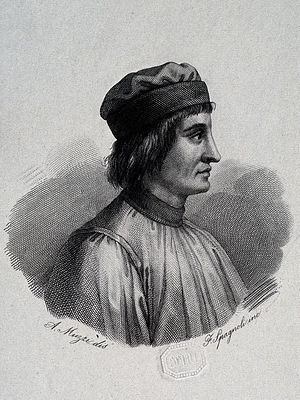Piero de' Crescenzi

Nineteenth-century engraved portrait of de' Crescenzi after Antonio Muzzi
|
|
| Born |
c. 1230/35 Bologna |
| Died | c. 1320 Bologna |
| Resting place | Basilica di San Domenico, Bologna |
| Occupation | jurist, writer |
| Language | Italian, Latin |
| Citizenship | Bolognese |
| Notable works | Ruralia commoda |
| Spouse |
|
Pietro de' Crescenzi (c. 1230/35 – c. 1320), Latin: Petrus de Crescentiis, was a Bolognese jurist, now remembered for his writings on horticulture and agriculture, the Ruralia commoda. There are many variant spellings of his name.
Pietro de' Crescenzi was born in Bologna in about 1235; the only evidence for his date of birth is the annotation "septuagenarian" in the Ruralia commoda, dated with some certainty between 1304 and 1309. He was educated at the University of Bologna in logic, medicine, the natural sciences and law, but did not take his doctorate. Crescenzi practiced as a lawyer and judge from about 1269 until 1299, travelling widely in Italy in the course of his work.
In January 1274 he married Geraldina de' Castagnoli, with whom he had at least five children. She died in or shortly after December 1287. In January 1289 he married Antonia de' Nascentori, with whom he also had several children.
After his retirement in 1298 he divided his time between Bologna and his country estate, the Villa dell'Olmo outside the walls of Bologna. During this time he wrote the Ruralia commoda, an agricultural treatise based largely on classical and medieval sources, as well as his own experience as a landowner.
It is not known when de' Crescenzi died. His last will is dated 23 June 1320; a legal document dated 25 February 1321 describes him as dead, at the age of almost ninety.
The Ruralia commoda, sometimes known as the Liber ruralium commodorum ("book of rural benefits"), was completed some time between 1304 and 1309, and was dedicated to Charles II of Naples. King Charles V of France ordered a French translation in 1373. After circulating in numerous manuscript copies, Crescenzi's treatise became the first printed modern text on agriculture when it was published in Augsburg by Johann Schüssler in 1471. Some 57 editions in Latin, Italian, French, and German appeared during the following century, as did two editions in Polish.
The structure and content of the Ruralia commoda is substantially based on the De re rustica of Lucius Junius Moderatus Columella, written in the first century AD, even though this work was not available to de' Crescenzi, and was known only in fragments until a complete version was discovered in a monastery library by Poggio Bracciolini during the Council of Constance, between 1414 and 1418. While de' Crescenzi cites Columella twelve times, all the citations are indirect, and taken from the Opus agriculturae of Rutilius Taurus Aemilianus Palladius. Like the De re rustica of Columella, the Ruralia commoda is divided into 12 parts:
...
Wikipedia
